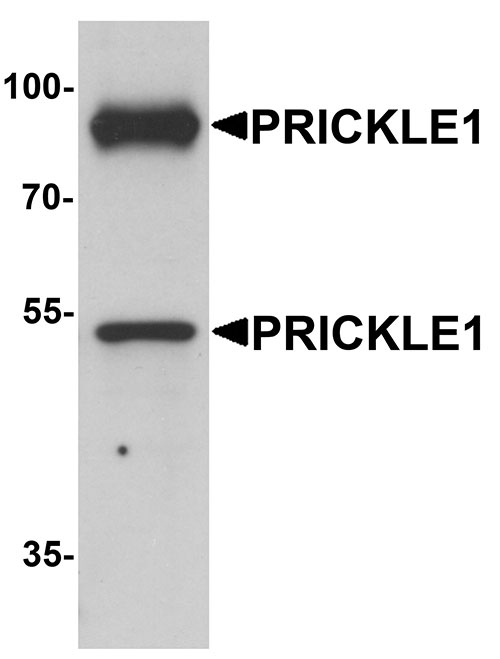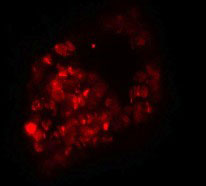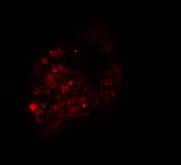PRICKLE1 Antibody
- 产品详情
- 实验流程
- 背景知识
Application
| WB, IF, E |
|---|---|
| Primary Accession | Q96MT3 |
| Other Accession | NP_694571, 222136684 |
| Reactivity | Human, Mouse, Rat |
| Host | Rabbit |
| Clonality | Polyclonal |
| Isotype | IgG |
| Calculated MW | 94300 Da |
| Concentration (mg/ml) | 1 mg/mL |
| Conjugate | Unconjugated |
| Application Notes | PRICKLE1 antibody can be used for detection of PRICKLE1 by Western blot at 1 µg/mL. Antibody can also be used for immunofluorescence starting at 20 µg/mL. For immunofluorescence start at 20 µg/mL. |
| Gene ID | 144165 |
|---|---|
| Other Names | Prickle-like protein 1, REST/NRSF-interacting LIM domain protein 1, PRICKLE1, RILP |
| Target/Specificity | PRICKLE1; Multiple isoforms of PRICKLE1 are known to exist. PRICKLE1 antibody is predicted to not cross-react with other PRICKLE protein family members. |
| Reconstitution & Storage | PRICKLE1 antibody can be stored at 4℃ for three months and -20℃, stable for up to one year. As with all antibodies care should be taken to avoid repeated freeze thaw cycles. Antibodies should not be exposed to prolonged high temperatures. |
| Precautions | PRICKLE1 Antibody is for research use only and not for use in diagnostic or therapeutic procedures. |
| Name | PRICKLE1 |
|---|---|
| Synonyms | RILP |
| Function | Involved in the planar cell polarity pathway that controls convergent extension during gastrulation and neural tube closure. Convergent extension is a complex morphogenetic process during which cells elongate, move mediolaterally, and intercalate between neighboring cells, leading to convergence toward the mediolateral axis and extension along the anteroposterior axis. Necessary for nuclear localization of REST. May serve as nuclear receptor. |
| Cellular Location | Nucleus membrane. Cytoplasm, cytosol. Note=A smaller amount is detected in the cytosol |
| Tissue Location | Expressed at highest levels in placenta and at lower levels in lung, liver, kidney and pancreas. Expressed in thalamus, hippocampus, cerebral cortex, and cerebellum (in neurons rather than glia). |
For Research Use Only. Not For Use In Diagnostic Procedures.
Provided below are standard protocols that you may find useful for product applications.
BACKGROUND
PRICKLE1 Antibody: PRICKLE1, also known as RILP or EPM1B, is a Disheveled-associated protein that serves as a nuclear translocation receptor for REST/NRSF and REST4 (1, 2). It contains three N-terminal LIM domains and three C-terminal nuclear localization signals. It localizes to the cytoplasm, as well as to the nuclear membrane and expressed at higher levels in placenta. PRICKLE1 is a negative regulator of the Wnt / beta-catenin signaling pathway and is a putative tumor suppressor in human HCCs. Defects in the gene encoding PRICKLE1 are associated with autosomal recessive progressive myoclonic epilepsy.
REFERENCES
Katoh M and Katoh M. Identification and characterization of human PRICKLE1 and PRICKLE2 genes as well as mouse Prickle1 and Prickle2 genes homologous to Drosophila tissue polarity gene prickle. Int. J. Mol. Med. 2003; 11:249-56
Shimojo M and Hersh LB. REST/NRSF-interacting LIM domain protein, a putative nuclear translocation receptor. Mol. Cell. Biol. 2003; 23:9025-31
Chan DW, Chan CY, Yam JW, et al. Prickle1 negatively regulates Wnt/β-catenin pathway by promoting Disheveled ubiquitination/degradation in liver cancer. Gastroenterology 2006; 131:1218-27.
Tao H, Manak JR, Sowers L, et al. Mutations in prickle orthologs cause seizures in flies, mice, and humans. Am. J. Hum. Genet. 2011; 88:138-49.
终于等到您。ABCEPTA(百远生物)抗体产品。
点击下方“我要评价 ”按钮提交您的反馈信息,您的反馈和评价是我们最宝贵的财富之一,
我们将在1-3个工作日内处理您的反馈信息。
如有疑问,联系:0512-88856768 tech-china@abcepta.com.























 癌症的基本特征包括细胞增殖、血管生成、迁移、凋亡逃避机制和细胞永生等。找到癌症发生过程中这些通路的关键标记物和对应的抗体用于检测至关重要。
癌症的基本特征包括细胞增殖、血管生成、迁移、凋亡逃避机制和细胞永生等。找到癌症发生过程中这些通路的关键标记物和对应的抗体用于检测至关重要。 为您推荐一个泛素化位点预测神器——泛素化分析工具,可以为您的蛋白的泛素化位点作出预测和评分。
为您推荐一个泛素化位点预测神器——泛素化分析工具,可以为您的蛋白的泛素化位点作出预测和评分。 细胞自噬受体图形绘图工具为你的蛋白的细胞受体结合位点作出预测和评分,识别结合到自噬通路中的蛋白是非常重要的,便于让我们理解自噬在正常生理、病理过程中的作用,如发育、细胞分化、神经退化性疾病、压力条件下、感染和癌症。
细胞自噬受体图形绘图工具为你的蛋白的细胞受体结合位点作出预测和评分,识别结合到自噬通路中的蛋白是非常重要的,便于让我们理解自噬在正常生理、病理过程中的作用,如发育、细胞分化、神经退化性疾病、压力条件下、感染和癌症。








